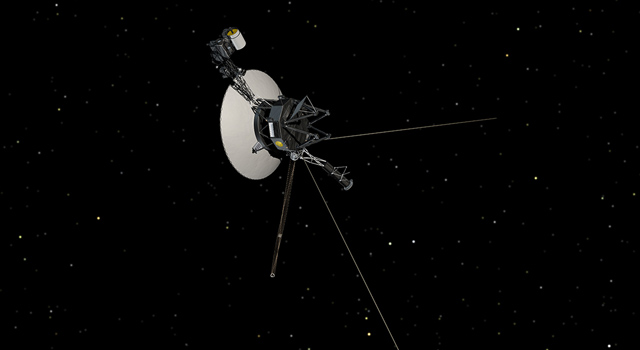News | April 9, 2002
Record Set for Most-Distant Spacecraft Maintenance

Astronauts can make service visits to the Earth-orbiting Hubble Space Telescope, but what do you do if the spacecraft needing a replacement part is the farthest human-made object from Earth, more than twice as distant as Pluto?
The answer, as the flight team for the Voyager Interstellar Mission recently demonstrated, is to plan ahead and keep top-notch engineers available.
Last month, the team cautiously activated a backup position-sensing system, including a Sun sensor and star tracker, on Voyager 1. The spacecraft had been carrying those components and other spare parts since it was launched in 1977 on what was then slated as a four-year mission.
"After sitting on the shelf for 25 years, it's like new equipment," said Ed Massey, Voyager project manager at NASA's Jet Propulsion Laboratory, Pasadena, Calif. Voyager 1 and its twin, Voyager 2, completed their history-making tour of outer planets in 1989 and are now headed toward the boundary zone -- called the heliopause -- where the Sun's influence cedes way to interstellar space. Both spacecraft have adequate power and communication capabilities to explore that frontier for about 20 more years, if other onboard systems hold up.
The original designers' foresight in building backup systems into the Voyagers helps, but making changeovers aboard a spacecraft more than 12.5 billion kilometers (7.8 billion miles) away presents enormous challenges. Anything that could go wrong needs to be foreseen, because reaction time is unforgivingly slow. Communication signals take nearly 12 hours each way traveling to or from Voyager 1 at the speed of light. And the task now falls to a Voyager flight team of just 14 people, compared with a Voyager team of more than 300 in the 1980s.
The success of the recent modifications gives the team confidence in switching to other backup systems on both spacecraft when concerns arise about original systems, Massey said.
Voyager 1's original attitude-control system showed slowly increasing signs of trouble in the past two years, said Tim Hogle, a flight-team engineer at JPL. Diagnostics pointed to an electronic component that takes analog signals from position-sensing devices and converts them into digital values for an onboard computer. Because of the system's design, switching to that component's backup also meant activating the backup Sun sensor and star tracker, which provide the reference points for the spacecraft's orientation in space.
"We had to plan this switch very carefully," Hogle said. This backup equipment hadn't been tested since Voyager 1 was approaching Saturn in 1980. If it didn't work right, switching to it could confuse the onboard computer about the spacecraft's orientation, which could lead to faulty pointing of the antenna and loss of communications with Earth.
Among other precautions, the team programmed a temporary changeover with an automatic reversion to the original system, allowing just enough time to evaluate the backup. The planning effort identified potential trouble points in advance and made provisions to be able to correct them, if necessary, before the final changeover, nine days after the temporary one. The cautious approach paid off. The system made an unexpected lock onto the Sun during the temporary switch, so the spacecraft was instructed to keep itself steady with gyroscopes during the final switch.
Calibration of the backup system was completed April 1.
"By switching to the backup before the original system failed, we now have the original as a backup if we need it," said flight-team member Steve Howard of JPL.
The changeover plan benefited from soliciting experienced advice from several Voyager veterans now working on other JPL projects. "We have resources here you just could not find anywhere else," Howard said.
Massey said, "The switchover went relatively smoothly. It is certainly a testament to the people who designed and built the spacecraft, and to the expertise and dedication of the flight team."
Information about Voyager's grand tour of the outer planets and the current Voyager Interstellar Mission is available online at http://voyager.jpl.nasa.gov . JPL, a division of the California Institute of Technology in Pasadena, manages Voyager for NASA's Office of Space Science, Washington, D.C.
